Systematic Review: Exercise Intervention for Depression in Australia
VerifiedAdded on 2023/01/17
|32
|4065
|41
Report
AI Summary
This systematic review investigates the efficacy of exercise-based interventions for depression management in Australia. The review employed the MEDLINE Complete electronic database, searching for articles published between 2014 and 2019. The methodology included specific search terms, inclusion and exclusion criteria, and a PRISMA flowchart. Out of 92 initial hits, only two articles met the final inclusion criteria after critical appraisal and ethical consideration. The study found a lack of significant association between exercise intervention and depression management, highlighting the need for further research. The report includes sections on background, rationale, research question, methodology, ethical considerations, limitations, and critical appraisals of the included articles, along with appendices detailing the search strategy and checklists for assessing the quality of the included studies.

Running head: SYSTEMATIC REVIEW
Exercise based intervention for depression management in Australia
Name of the Student
Name of the University
Author note
Exercise based intervention for depression management in Australia
Name of the Student
Name of the University
Author note
Paraphrase This Document
Need a fresh take? Get an instant paraphrase of this document with our AI Paraphraser
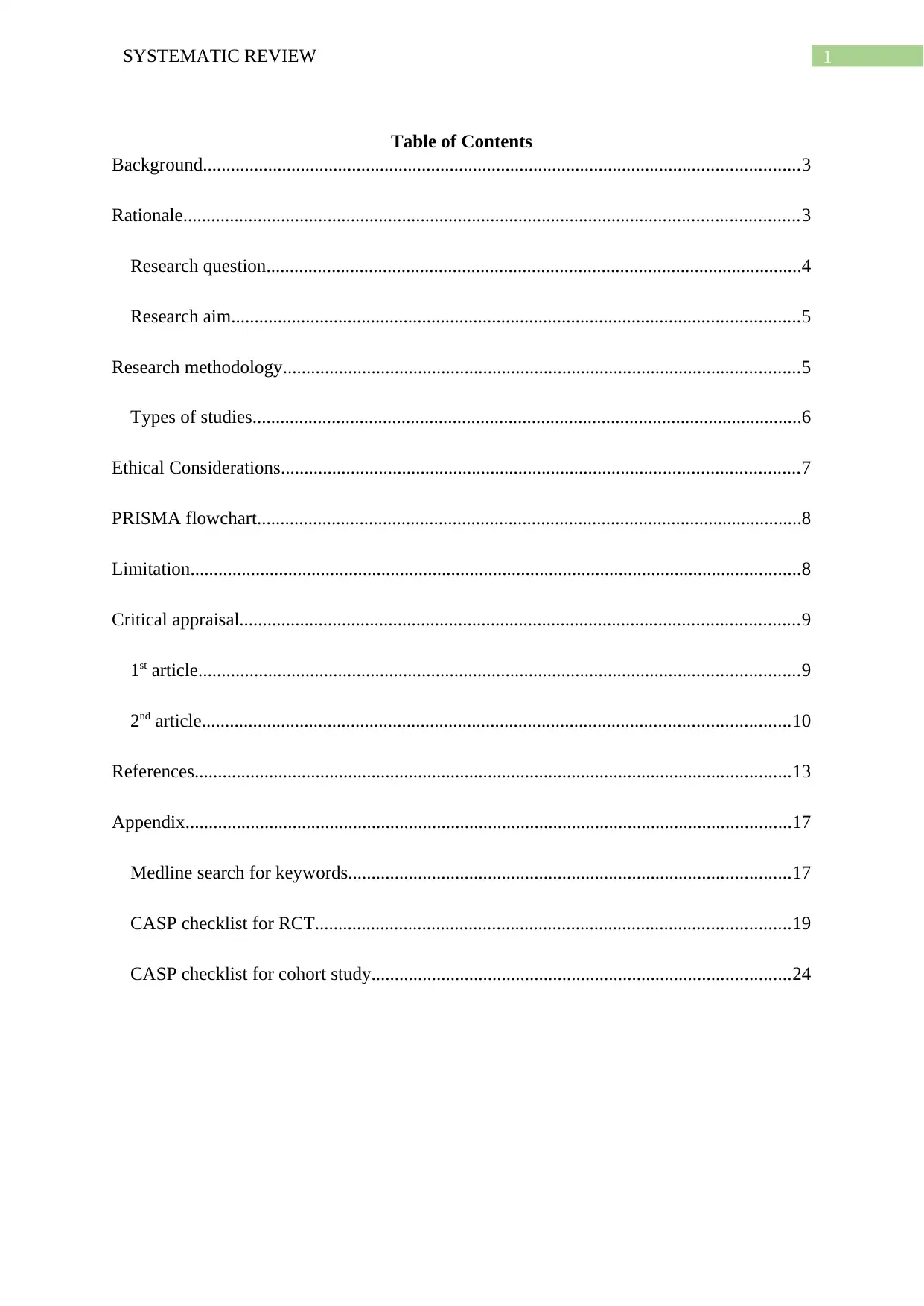
1SYSTEMATIC REVIEW
Table of Contents
Background................................................................................................................................3
Rationale....................................................................................................................................3
Research question...................................................................................................................4
Research aim..........................................................................................................................5
Research methodology...............................................................................................................5
Types of studies......................................................................................................................6
Ethical Considerations...............................................................................................................7
PRISMA flowchart.....................................................................................................................8
Limitation...................................................................................................................................8
Critical appraisal........................................................................................................................9
1st article.................................................................................................................................9
2nd article..............................................................................................................................10
References................................................................................................................................13
Appendix..................................................................................................................................17
Medline search for keywords...............................................................................................17
CASP checklist for RCT......................................................................................................19
CASP checklist for cohort study..........................................................................................24
Table of Contents
Background................................................................................................................................3
Rationale....................................................................................................................................3
Research question...................................................................................................................4
Research aim..........................................................................................................................5
Research methodology...............................................................................................................5
Types of studies......................................................................................................................6
Ethical Considerations...............................................................................................................7
PRISMA flowchart.....................................................................................................................8
Limitation...................................................................................................................................8
Critical appraisal........................................................................................................................9
1st article.................................................................................................................................9
2nd article..............................................................................................................................10
References................................................................................................................................13
Appendix..................................................................................................................................17
Medline search for keywords...............................................................................................17
CASP checklist for RCT......................................................................................................19
CASP checklist for cohort study..........................................................................................24

2SYSTEMATIC REVIEW
Abstract
Background- Depression refers to a mood disorder that is characterized by feeling of low
mood, sadness, and loss of interest in things. Exercise interventions have been found effective
in treatment of several psychiatric disorders by creating an impact on neuroplasticity.
Objective- To determine the effects of exercise based interventions for depression
management.
Methods- A systematic literature review conducted through the MEDLINE Complete
electronic database, for articles published between 2014-2019, using different search terms.
Articles were included and excluded based on a definite criteria, followed by creating a
PRISMA flowchart.
Results- Of the 92 hits obtained from the database, 83 were excluded based on their abstract
and title. 9 articles were analysed for ethical consideration and inclusion criteria, after which
two were included in the final review.
Conclusion- Lack of significant association between exercise intervention and depression
management calls for the need of further research.
Abstract
Background- Depression refers to a mood disorder that is characterized by feeling of low
mood, sadness, and loss of interest in things. Exercise interventions have been found effective
in treatment of several psychiatric disorders by creating an impact on neuroplasticity.
Objective- To determine the effects of exercise based interventions for depression
management.
Methods- A systematic literature review conducted through the MEDLINE Complete
electronic database, for articles published between 2014-2019, using different search terms.
Articles were included and excluded based on a definite criteria, followed by creating a
PRISMA flowchart.
Results- Of the 92 hits obtained from the database, 83 were excluded based on their abstract
and title. 9 articles were analysed for ethical consideration and inclusion criteria, after which
two were included in the final review.
Conclusion- Lack of significant association between exercise intervention and depression
management calls for the need of further research.
⊘ This is a preview!⊘
Do you want full access?
Subscribe today to unlock all pages.

Trusted by 1+ million students worldwide
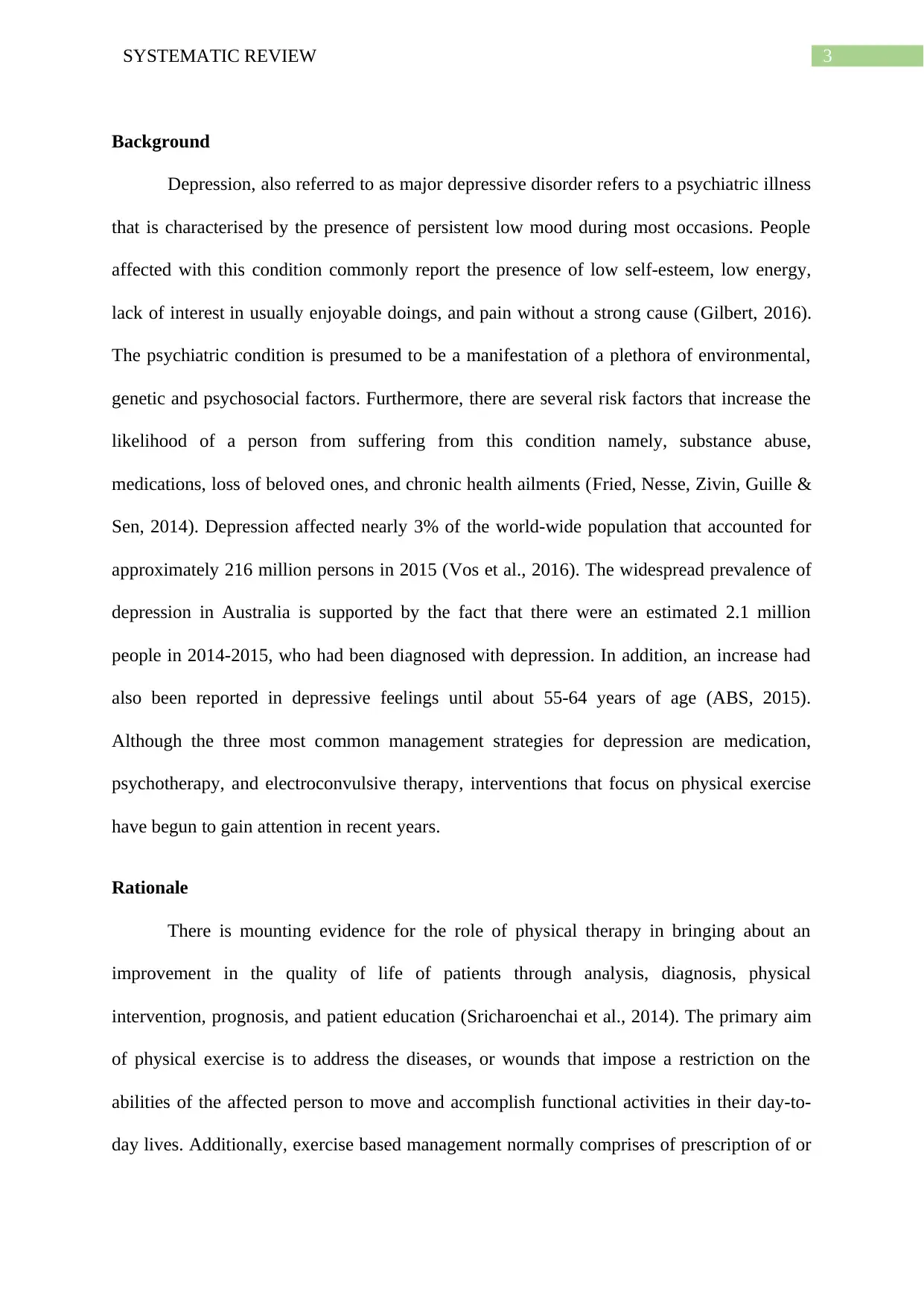
3SYSTEMATIC REVIEW
Background
Depression, also referred to as major depressive disorder refers to a psychiatric illness
that is characterised by the presence of persistent low mood during most occasions. People
affected with this condition commonly report the presence of low self-esteem, low energy,
lack of interest in usually enjoyable doings, and pain without a strong cause (Gilbert, 2016).
The psychiatric condition is presumed to be a manifestation of a plethora of environmental,
genetic and psychosocial factors. Furthermore, there are several risk factors that increase the
likelihood of a person from suffering from this condition namely, substance abuse,
medications, loss of beloved ones, and chronic health ailments (Fried, Nesse, Zivin, Guille &
Sen, 2014). Depression affected nearly 3% of the world-wide population that accounted for
approximately 216 million persons in 2015 (Vos et al., 2016). The widespread prevalence of
depression in Australia is supported by the fact that there were an estimated 2.1 million
people in 2014-2015, who had been diagnosed with depression. In addition, an increase had
also been reported in depressive feelings until about 55-64 years of age (ABS, 2015).
Although the three most common management strategies for depression are medication,
psychotherapy, and electroconvulsive therapy, interventions that focus on physical exercise
have begun to gain attention in recent years.
Rationale
There is mounting evidence for the role of physical therapy in bringing about an
improvement in the quality of life of patients through analysis, diagnosis, physical
intervention, prognosis, and patient education (Sricharoenchai et al., 2014). The primary aim
of physical exercise is to address the diseases, or wounds that impose a restriction on the
abilities of the affected person to move and accomplish functional activities in their day-to-
day lives. Additionally, exercise based management normally comprises of prescription of or
Background
Depression, also referred to as major depressive disorder refers to a psychiatric illness
that is characterised by the presence of persistent low mood during most occasions. People
affected with this condition commonly report the presence of low self-esteem, low energy,
lack of interest in usually enjoyable doings, and pain without a strong cause (Gilbert, 2016).
The psychiatric condition is presumed to be a manifestation of a plethora of environmental,
genetic and psychosocial factors. Furthermore, there are several risk factors that increase the
likelihood of a person from suffering from this condition namely, substance abuse,
medications, loss of beloved ones, and chronic health ailments (Fried, Nesse, Zivin, Guille &
Sen, 2014). Depression affected nearly 3% of the world-wide population that accounted for
approximately 216 million persons in 2015 (Vos et al., 2016). The widespread prevalence of
depression in Australia is supported by the fact that there were an estimated 2.1 million
people in 2014-2015, who had been diagnosed with depression. In addition, an increase had
also been reported in depressive feelings until about 55-64 years of age (ABS, 2015).
Although the three most common management strategies for depression are medication,
psychotherapy, and electroconvulsive therapy, interventions that focus on physical exercise
have begun to gain attention in recent years.
Rationale
There is mounting evidence for the role of physical therapy in bringing about an
improvement in the quality of life of patients through analysis, diagnosis, physical
intervention, prognosis, and patient education (Sricharoenchai et al., 2014). The primary aim
of physical exercise is to address the diseases, or wounds that impose a restriction on the
abilities of the affected person to move and accomplish functional activities in their day-to-
day lives. Additionally, exercise based management normally comprises of prescription of or
Paraphrase This Document
Need a fresh take? Get an instant paraphrase of this document with our AI Paraphraser

4SYSTEMATIC REVIEW
help with manual therapy, definite exercises, and operation, mechanical equipment such as,
traction, use of physical agents like cold, heat, electricity, prostheses, and assistive devices.
Time and again it has been found that practitioners implement exercise based regimen among
patients, in order to avert the loss of movement through the formulation and enforcement of
wellness and fitness oriented programs (de Labra, Guimaraes-Pinheiro, Maseda, Lorenzo &
Millán-Calenti, 2015).
Results from a research study helped in the identification of four themes that create an
influence on the patient-therapist interaction such as, practical skills, communication and
interpersonal skills, administrative and environmental factors, and customised patient-centred
care (O'keeffe et al., 2016). Furthermore, research evidences have highlighted the fact that
exercise results in an increased generation and expression of the neuropeptide BDNF, thus
leading to an increase in signalling through the tyrosine kinase receptor and tropomyosin
receptor kinase B (Phillips, Baktir, Srivatsan & Salehi, 2014). Exercise-mediated BDNF
changes in signalling lead to an improvement in mood, memory and cognitive function.
According to Szuhany, Bugatti and Otto (2015) exercise is related with augmented IGF-1
blood serum levels, which significantly contributes to brain neuroplasticity, owing to its
capability of crossing the blood–cerebrospinal fluid barrier and blood–brain barrier.
Furthermore, exercise-mediated rise in VEGF signalling enhances cerebral blood volume,
thereby leading to hippocampal neurogenesis (Silverman & Deuster, 2014).
Research question
The PICO framework was used for formulating a well-focused research question that
would facilitate literature search for the systematic review:
P Depression patients
I Exercise-based intervention
help with manual therapy, definite exercises, and operation, mechanical equipment such as,
traction, use of physical agents like cold, heat, electricity, prostheses, and assistive devices.
Time and again it has been found that practitioners implement exercise based regimen among
patients, in order to avert the loss of movement through the formulation and enforcement of
wellness and fitness oriented programs (de Labra, Guimaraes-Pinheiro, Maseda, Lorenzo &
Millán-Calenti, 2015).
Results from a research study helped in the identification of four themes that create an
influence on the patient-therapist interaction such as, practical skills, communication and
interpersonal skills, administrative and environmental factors, and customised patient-centred
care (O'keeffe et al., 2016). Furthermore, research evidences have highlighted the fact that
exercise results in an increased generation and expression of the neuropeptide BDNF, thus
leading to an increase in signalling through the tyrosine kinase receptor and tropomyosin
receptor kinase B (Phillips, Baktir, Srivatsan & Salehi, 2014). Exercise-mediated BDNF
changes in signalling lead to an improvement in mood, memory and cognitive function.
According to Szuhany, Bugatti and Otto (2015) exercise is related with augmented IGF-1
blood serum levels, which significantly contributes to brain neuroplasticity, owing to its
capability of crossing the blood–cerebrospinal fluid barrier and blood–brain barrier.
Furthermore, exercise-mediated rise in VEGF signalling enhances cerebral blood volume,
thereby leading to hippocampal neurogenesis (Silverman & Deuster, 2014).
Research question
The PICO framework was used for formulating a well-focused research question that
would facilitate literature search for the systematic review:
P Depression patients
I Exercise-based intervention

5SYSTEMATIC REVIEW
C Conventional treatment
O Improved symptoms
Table 1- PICO framework
The research question generated from the aforementioned components is given below:
What is the efficacy of exercise based intervention for depression management in
Australia?
Research aim
To determine the efficacy of exercise based intervention for depression management
in Australia.
Research methodology
Systematic literature search was conducted in the electronic database MEDLINE
Complete, for the extraction of scholarly evidences that were relevant to the research
phenomenon. The above-mentioned electronic database has been selected due to its
significance to the healthcare and bioscience domain (McGowan et al., 2016). Published
literature were only cited in these databases. The systematic review concentrated on
assortment of evidence from appropriate published works, including professional-body
publications and peer-reviewed journals. The search was conducted after seeking consultation
from the coordinator of the university library services. Article search was performed on April
10, 2019 with the use of specific key terms and phrases. With the aim of ensuring retrieval of
all available relevant literature, some of the major search strategy expanding practices
included the following:
probing for a group of appropriate keywords and their substitutes by using free-text
terms and ‘medical subject heading’ (MeSH), with or without any truncation (‘*’ or
‘$’) for easing the accumulation of stem words (Aromataris & Riitano, 2014)
C Conventional treatment
O Improved symptoms
Table 1- PICO framework
The research question generated from the aforementioned components is given below:
What is the efficacy of exercise based intervention for depression management in
Australia?
Research aim
To determine the efficacy of exercise based intervention for depression management
in Australia.
Research methodology
Systematic literature search was conducted in the electronic database MEDLINE
Complete, for the extraction of scholarly evidences that were relevant to the research
phenomenon. The above-mentioned electronic database has been selected due to its
significance to the healthcare and bioscience domain (McGowan et al., 2016). Published
literature were only cited in these databases. The systematic review concentrated on
assortment of evidence from appropriate published works, including professional-body
publications and peer-reviewed journals. The search was conducted after seeking consultation
from the coordinator of the university library services. Article search was performed on April
10, 2019 with the use of specific key terms and phrases. With the aim of ensuring retrieval of
all available relevant literature, some of the major search strategy expanding practices
included the following:
probing for a group of appropriate keywords and their substitutes by using free-text
terms and ‘medical subject heading’ (MeSH), with or without any truncation (‘*’ or
‘$’) for easing the accumulation of stem words (Aromataris & Riitano, 2014)
⊘ This is a preview!⊘
Do you want full access?
Subscribe today to unlock all pages.

Trusted by 1+ million students worldwide

6SYSTEMATIC REVIEW
searching for catchwords in quotation signs; and
using Boolean operators (‘AND’ and ‘OR’) for joining the keywords
Below listed are the search terms and phrases that were fed into the electronic database for
the advanced search process:
“depressive disorder” OR “major depressive disorder” OR “depression” OR “low
mood” OR “MDD”.
AND
“physical activity” “walking” “physical fitness” “jogging” “physical exercise”
“running” “aerobic exercise” “bicycling” “swimming” “resistance”.
AND
“improved symptoms” OR “management” OR “treatment” OR “patient satisfaction”
OR “improved mood” OR “behaviour” OR “severity” OR “health” OR “quality of
life”.
Types of studies
The literature search was based on primary research articles that comprised of
randomized controlled trials, experimental studies, observational studies, pilot studies and/or
pre- and post-intervention trials having at least 10 or more study subjects. The inclusion and
exclusion criteria for extracting relevant articles are given below:
Inclusion criteria Exclusion criteria
Primary research Secondary research, case report or abstracts
Adult patients with depression Patients with mental disorder other than
depression
Exercise or physical therapy as main Other lifestyle based intervention
searching for catchwords in quotation signs; and
using Boolean operators (‘AND’ and ‘OR’) for joining the keywords
Below listed are the search terms and phrases that were fed into the electronic database for
the advanced search process:
“depressive disorder” OR “major depressive disorder” OR “depression” OR “low
mood” OR “MDD”.
AND
“physical activity” “walking” “physical fitness” “jogging” “physical exercise”
“running” “aerobic exercise” “bicycling” “swimming” “resistance”.
AND
“improved symptoms” OR “management” OR “treatment” OR “patient satisfaction”
OR “improved mood” OR “behaviour” OR “severity” OR “health” OR “quality of
life”.
Types of studies
The literature search was based on primary research articles that comprised of
randomized controlled trials, experimental studies, observational studies, pilot studies and/or
pre- and post-intervention trials having at least 10 or more study subjects. The inclusion and
exclusion criteria for extracting relevant articles are given below:
Inclusion criteria Exclusion criteria
Primary research Secondary research, case report or abstracts
Adult patients with depression Patients with mental disorder other than
depression
Exercise or physical therapy as main Other lifestyle based intervention
Paraphrase This Document
Need a fresh take? Get an instant paraphrase of this document with our AI Paraphraser
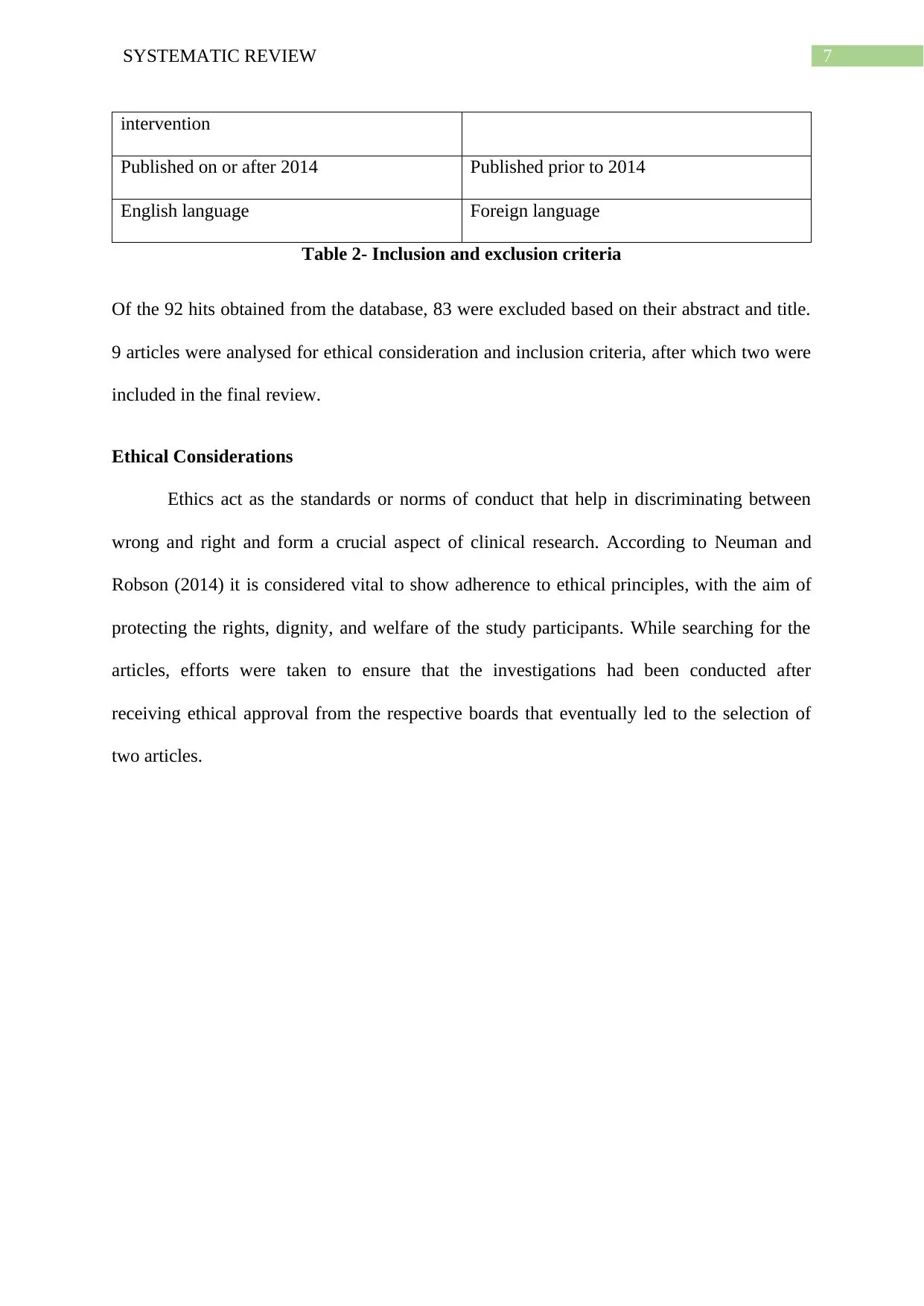
7SYSTEMATIC REVIEW
intervention
Published on or after 2014 Published prior to 2014
English language Foreign language
Table 2- Inclusion and exclusion criteria
Of the 92 hits obtained from the database, 83 were excluded based on their abstract and title.
9 articles were analysed for ethical consideration and inclusion criteria, after which two were
included in the final review.
Ethical Considerations
Ethics act as the standards or norms of conduct that help in discriminating between
wrong and right and form a crucial aspect of clinical research. According to Neuman and
Robson (2014) it is considered vital to show adherence to ethical principles, with the aim of
protecting the rights, dignity, and welfare of the study participants. While searching for the
articles, efforts were taken to ensure that the investigations had been conducted after
receiving ethical approval from the respective boards that eventually led to the selection of
two articles.
intervention
Published on or after 2014 Published prior to 2014
English language Foreign language
Table 2- Inclusion and exclusion criteria
Of the 92 hits obtained from the database, 83 were excluded based on their abstract and title.
9 articles were analysed for ethical consideration and inclusion criteria, after which two were
included in the final review.
Ethical Considerations
Ethics act as the standards or norms of conduct that help in discriminating between
wrong and right and form a crucial aspect of clinical research. According to Neuman and
Robson (2014) it is considered vital to show adherence to ethical principles, with the aim of
protecting the rights, dignity, and welfare of the study participants. While searching for the
articles, efforts were taken to ensure that the investigations had been conducted after
receiving ethical approval from the respective boards that eventually led to the selection of
two articles.
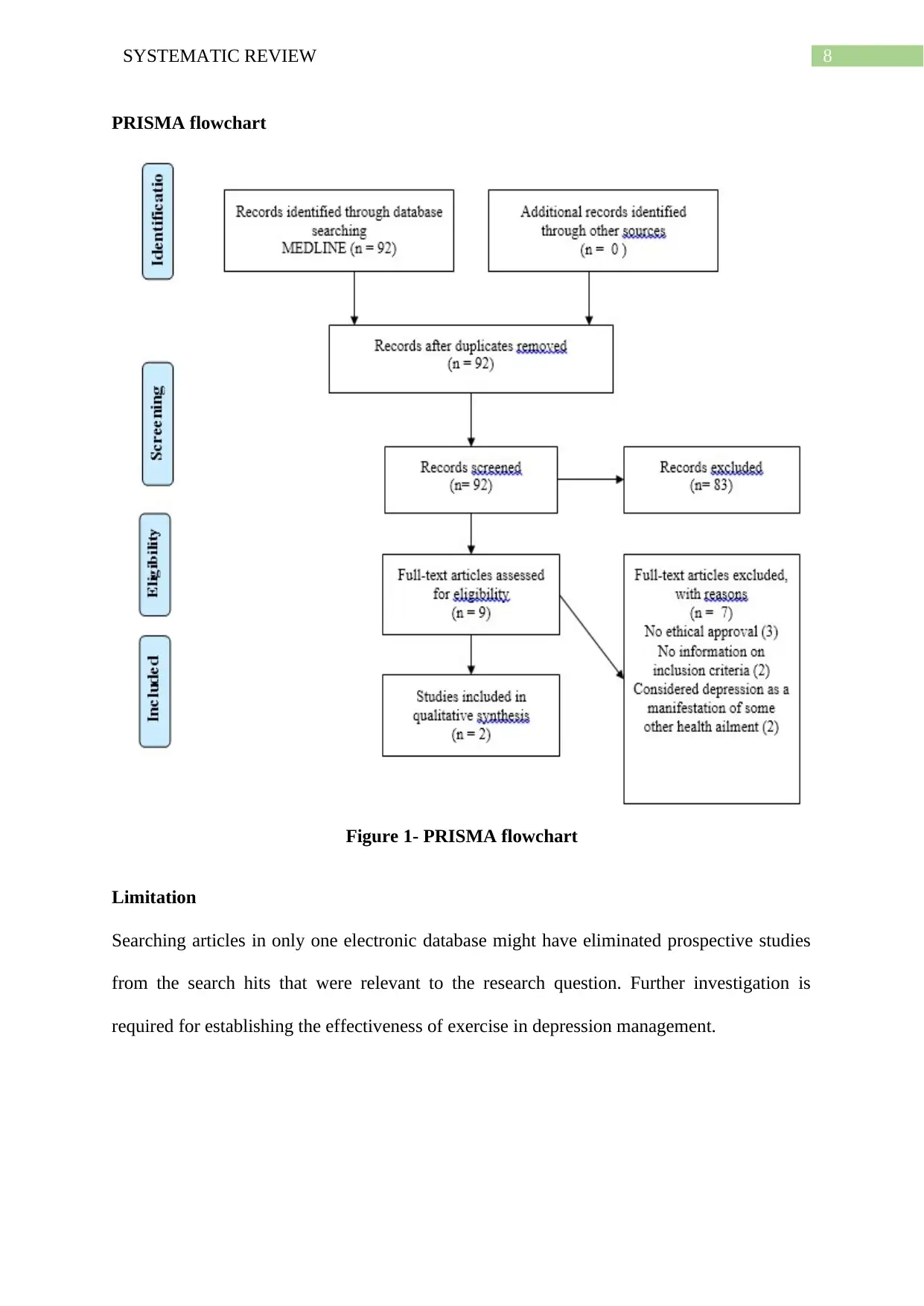
8SYSTEMATIC REVIEW
PRISMA flowchart
Figure 1- PRISMA flowchart
Limitation
Searching articles in only one electronic database might have eliminated prospective studies
from the search hits that were relevant to the research question. Further investigation is
required for establishing the effectiveness of exercise in depression management.
PRISMA flowchart
Figure 1- PRISMA flowchart
Limitation
Searching articles in only one electronic database might have eliminated prospective studies
from the search hits that were relevant to the research question. Further investigation is
required for establishing the effectiveness of exercise in depression management.
⊘ This is a preview!⊘
Do you want full access?
Subscribe today to unlock all pages.

Trusted by 1+ million students worldwide
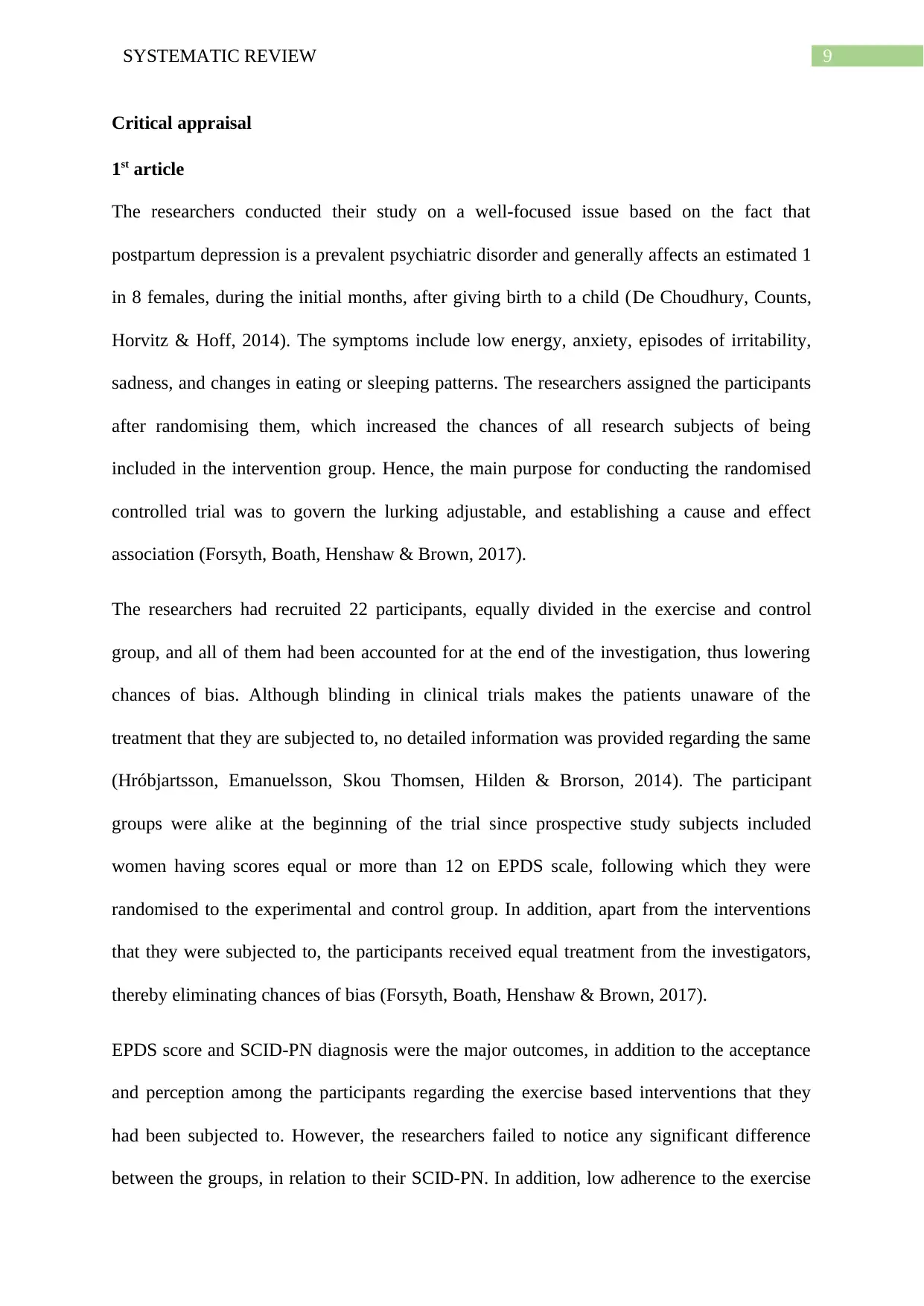
9SYSTEMATIC REVIEW
Critical appraisal
1st article
The researchers conducted their study on a well-focused issue based on the fact that
postpartum depression is a prevalent psychiatric disorder and generally affects an estimated 1
in 8 females, during the initial months, after giving birth to a child (De Choudhury, Counts,
Horvitz & Hoff, 2014). The symptoms include low energy, anxiety, episodes of irritability,
sadness, and changes in eating or sleeping patterns. The researchers assigned the participants
after randomising them, which increased the chances of all research subjects of being
included in the intervention group. Hence, the main purpose for conducting the randomised
controlled trial was to govern the lurking adjustable, and establishing a cause and effect
association (Forsyth, Boath, Henshaw & Brown, 2017).
The researchers had recruited 22 participants, equally divided in the exercise and control
group, and all of them had been accounted for at the end of the investigation, thus lowering
chances of bias. Although blinding in clinical trials makes the patients unaware of the
treatment that they are subjected to, no detailed information was provided regarding the same
(Hróbjartsson, Emanuelsson, Skou Thomsen, Hilden & Brorson, 2014). The participant
groups were alike at the beginning of the trial since prospective study subjects included
women having scores equal or more than 12 on EPDS scale, following which they were
randomised to the experimental and control group. In addition, apart from the interventions
that they were subjected to, the participants received equal treatment from the investigators,
thereby eliminating chances of bias (Forsyth, Boath, Henshaw & Brown, 2017).
EPDS score and SCID-PN diagnosis were the major outcomes, in addition to the acceptance
and perception among the participants regarding the exercise based interventions that they
had been subjected to. However, the researchers failed to notice any significant difference
between the groups, in relation to their SCID-PN. In addition, low adherence to the exercise
Critical appraisal
1st article
The researchers conducted their study on a well-focused issue based on the fact that
postpartum depression is a prevalent psychiatric disorder and generally affects an estimated 1
in 8 females, during the initial months, after giving birth to a child (De Choudhury, Counts,
Horvitz & Hoff, 2014). The symptoms include low energy, anxiety, episodes of irritability,
sadness, and changes in eating or sleeping patterns. The researchers assigned the participants
after randomising them, which increased the chances of all research subjects of being
included in the intervention group. Hence, the main purpose for conducting the randomised
controlled trial was to govern the lurking adjustable, and establishing a cause and effect
association (Forsyth, Boath, Henshaw & Brown, 2017).
The researchers had recruited 22 participants, equally divided in the exercise and control
group, and all of them had been accounted for at the end of the investigation, thus lowering
chances of bias. Although blinding in clinical trials makes the patients unaware of the
treatment that they are subjected to, no detailed information was provided regarding the same
(Hróbjartsson, Emanuelsson, Skou Thomsen, Hilden & Brorson, 2014). The participant
groups were alike at the beginning of the trial since prospective study subjects included
women having scores equal or more than 12 on EPDS scale, following which they were
randomised to the experimental and control group. In addition, apart from the interventions
that they were subjected to, the participants received equal treatment from the investigators,
thereby eliminating chances of bias (Forsyth, Boath, Henshaw & Brown, 2017).
EPDS score and SCID-PN diagnosis were the major outcomes, in addition to the acceptance
and perception among the participants regarding the exercise based interventions that they
had been subjected to. However, the researchers failed to notice any significant difference
between the groups, in relation to their SCID-PN. In addition, low adherence to the exercise
Paraphrase This Document
Need a fresh take? Get an instant paraphrase of this document with our AI Paraphraser
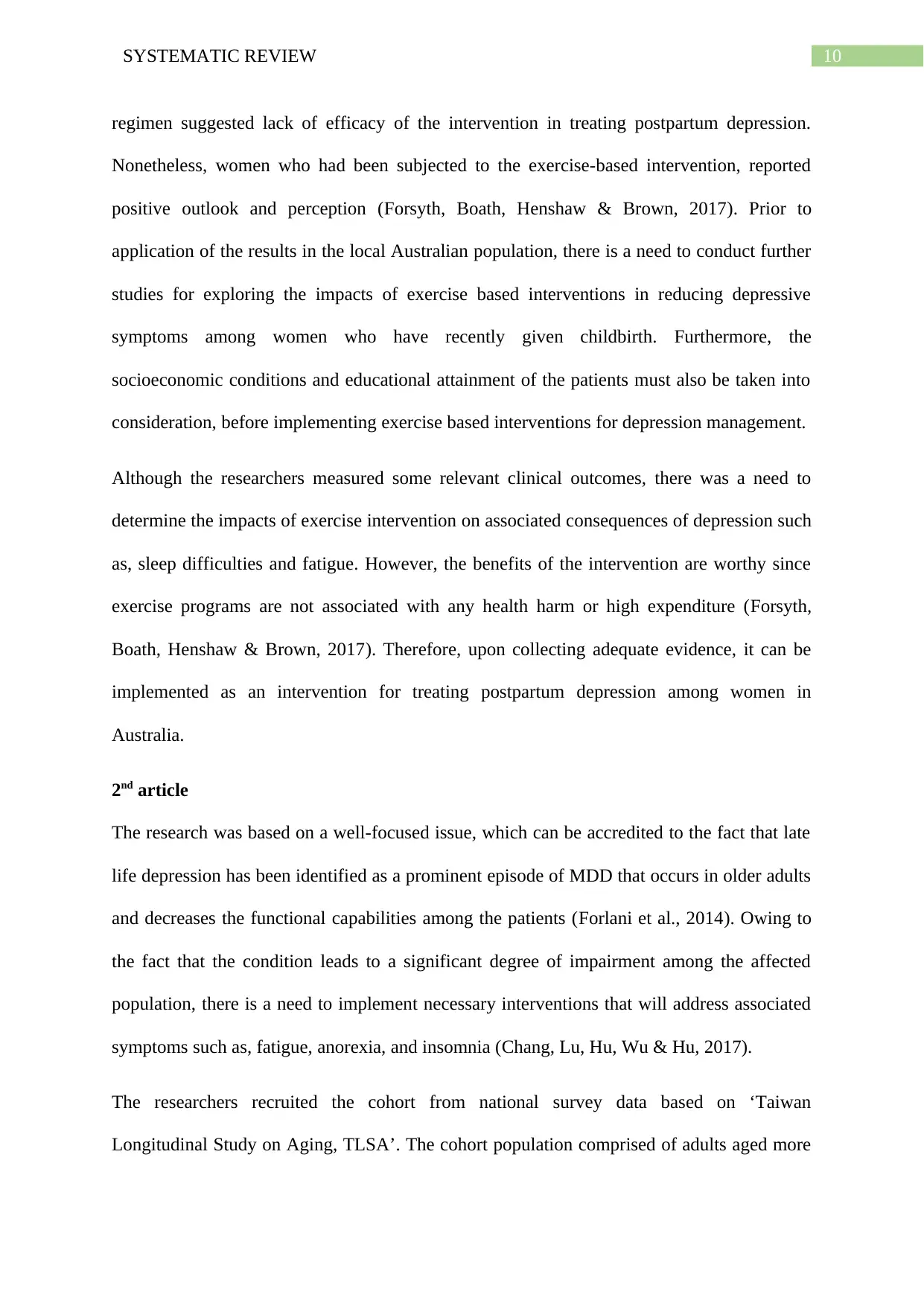
10SYSTEMATIC REVIEW
regimen suggested lack of efficacy of the intervention in treating postpartum depression.
Nonetheless, women who had been subjected to the exercise-based intervention, reported
positive outlook and perception (Forsyth, Boath, Henshaw & Brown, 2017). Prior to
application of the results in the local Australian population, there is a need to conduct further
studies for exploring the impacts of exercise based interventions in reducing depressive
symptoms among women who have recently given childbirth. Furthermore, the
socioeconomic conditions and educational attainment of the patients must also be taken into
consideration, before implementing exercise based interventions for depression management.
Although the researchers measured some relevant clinical outcomes, there was a need to
determine the impacts of exercise intervention on associated consequences of depression such
as, sleep difficulties and fatigue. However, the benefits of the intervention are worthy since
exercise programs are not associated with any health harm or high expenditure (Forsyth,
Boath, Henshaw & Brown, 2017). Therefore, upon collecting adequate evidence, it can be
implemented as an intervention for treating postpartum depression among women in
Australia.
2nd article
The research was based on a well-focused issue, which can be accredited to the fact that late
life depression has been identified as a prominent episode of MDD that occurs in older adults
and decreases the functional capabilities among the patients (Forlani et al., 2014). Owing to
the fact that the condition leads to a significant degree of impairment among the affected
population, there is a need to implement necessary interventions that will address associated
symptoms such as, fatigue, anorexia, and insomnia (Chang, Lu, Hu, Wu & Hu, 2017).
The researchers recruited the cohort from national survey data based on ‘Taiwan
Longitudinal Study on Aging, TLSA’. The cohort population comprised of adults aged more
regimen suggested lack of efficacy of the intervention in treating postpartum depression.
Nonetheless, women who had been subjected to the exercise-based intervention, reported
positive outlook and perception (Forsyth, Boath, Henshaw & Brown, 2017). Prior to
application of the results in the local Australian population, there is a need to conduct further
studies for exploring the impacts of exercise based interventions in reducing depressive
symptoms among women who have recently given childbirth. Furthermore, the
socioeconomic conditions and educational attainment of the patients must also be taken into
consideration, before implementing exercise based interventions for depression management.
Although the researchers measured some relevant clinical outcomes, there was a need to
determine the impacts of exercise intervention on associated consequences of depression such
as, sleep difficulties and fatigue. However, the benefits of the intervention are worthy since
exercise programs are not associated with any health harm or high expenditure (Forsyth,
Boath, Henshaw & Brown, 2017). Therefore, upon collecting adequate evidence, it can be
implemented as an intervention for treating postpartum depression among women in
Australia.
2nd article
The research was based on a well-focused issue, which can be accredited to the fact that late
life depression has been identified as a prominent episode of MDD that occurs in older adults
and decreases the functional capabilities among the patients (Forlani et al., 2014). Owing to
the fact that the condition leads to a significant degree of impairment among the affected
population, there is a need to implement necessary interventions that will address associated
symptoms such as, fatigue, anorexia, and insomnia (Chang, Lu, Hu, Wu & Hu, 2017).
The researchers recruited the cohort from national survey data based on ‘Taiwan
Longitudinal Study on Aging, TLSA’. The cohort population comprised of adults aged more
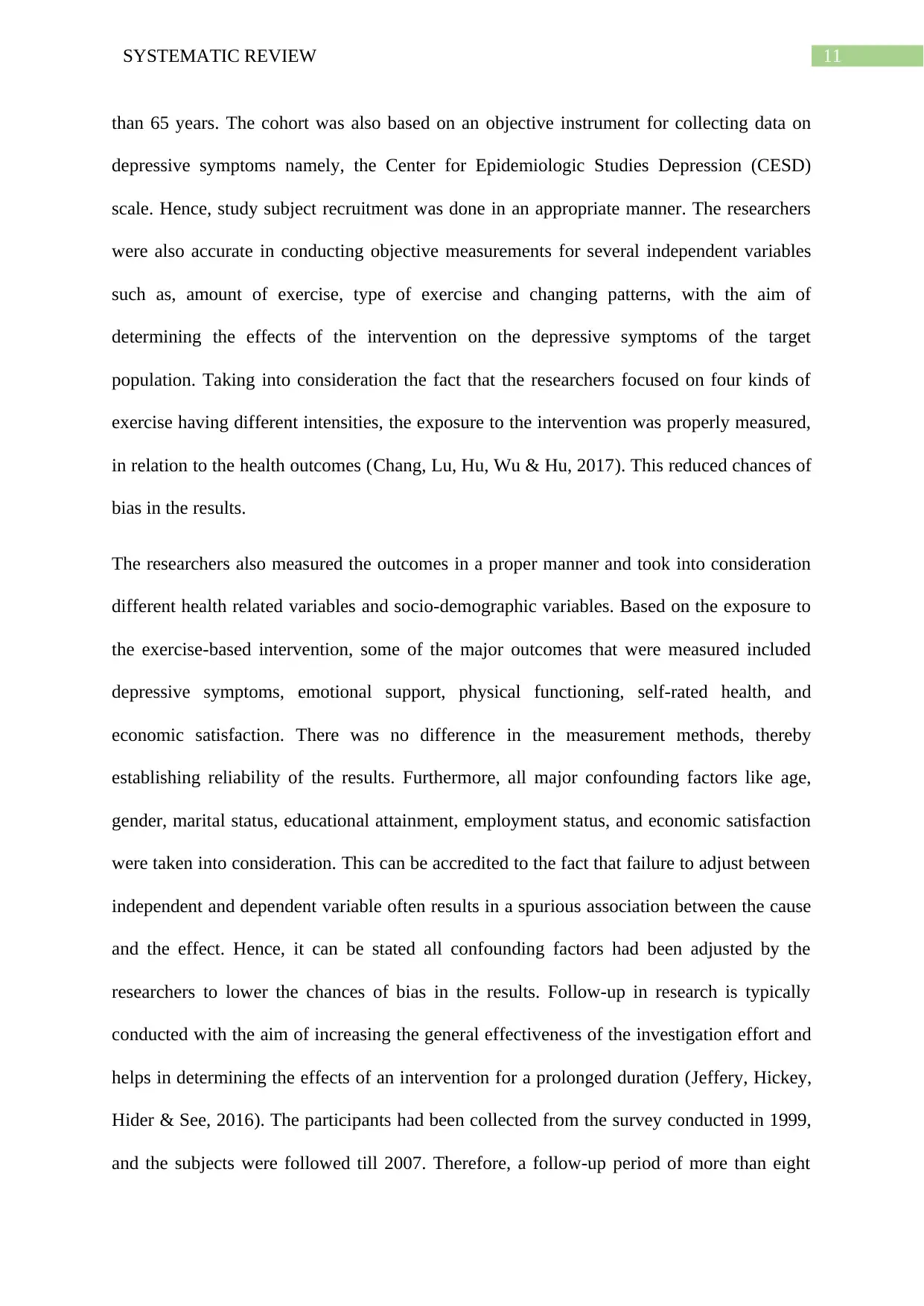
11SYSTEMATIC REVIEW
than 65 years. The cohort was also based on an objective instrument for collecting data on
depressive symptoms namely, the Center for Epidemiologic Studies Depression (CESD)
scale. Hence, study subject recruitment was done in an appropriate manner. The researchers
were also accurate in conducting objective measurements for several independent variables
such as, amount of exercise, type of exercise and changing patterns, with the aim of
determining the effects of the intervention on the depressive symptoms of the target
population. Taking into consideration the fact that the researchers focused on four kinds of
exercise having different intensities, the exposure to the intervention was properly measured,
in relation to the health outcomes (Chang, Lu, Hu, Wu & Hu, 2017). This reduced chances of
bias in the results.
The researchers also measured the outcomes in a proper manner and took into consideration
different health related variables and socio-demographic variables. Based on the exposure to
the exercise-based intervention, some of the major outcomes that were measured included
depressive symptoms, emotional support, physical functioning, self-rated health, and
economic satisfaction. There was no difference in the measurement methods, thereby
establishing reliability of the results. Furthermore, all major confounding factors like age,
gender, marital status, educational attainment, employment status, and economic satisfaction
were taken into consideration. This can be accredited to the fact that failure to adjust between
independent and dependent variable often results in a spurious association between the cause
and the effect. Hence, it can be stated all confounding factors had been adjusted by the
researchers to lower the chances of bias in the results. Follow-up in research is typically
conducted with the aim of increasing the general effectiveness of the investigation effort and
helps in determining the effects of an intervention for a prolonged duration (Jeffery, Hickey,
Hider & See, 2016). The participants had been collected from the survey conducted in 1999,
and the subjects were followed till 2007. Therefore, a follow-up period of more than eight
than 65 years. The cohort was also based on an objective instrument for collecting data on
depressive symptoms namely, the Center for Epidemiologic Studies Depression (CESD)
scale. Hence, study subject recruitment was done in an appropriate manner. The researchers
were also accurate in conducting objective measurements for several independent variables
such as, amount of exercise, type of exercise and changing patterns, with the aim of
determining the effects of the intervention on the depressive symptoms of the target
population. Taking into consideration the fact that the researchers focused on four kinds of
exercise having different intensities, the exposure to the intervention was properly measured,
in relation to the health outcomes (Chang, Lu, Hu, Wu & Hu, 2017). This reduced chances of
bias in the results.
The researchers also measured the outcomes in a proper manner and took into consideration
different health related variables and socio-demographic variables. Based on the exposure to
the exercise-based intervention, some of the major outcomes that were measured included
depressive symptoms, emotional support, physical functioning, self-rated health, and
economic satisfaction. There was no difference in the measurement methods, thereby
establishing reliability of the results. Furthermore, all major confounding factors like age,
gender, marital status, educational attainment, employment status, and economic satisfaction
were taken into consideration. This can be accredited to the fact that failure to adjust between
independent and dependent variable often results in a spurious association between the cause
and the effect. Hence, it can be stated all confounding factors had been adjusted by the
researchers to lower the chances of bias in the results. Follow-up in research is typically
conducted with the aim of increasing the general effectiveness of the investigation effort and
helps in determining the effects of an intervention for a prolonged duration (Jeffery, Hickey,
Hider & See, 2016). The participants had been collected from the survey conducted in 1999,
and the subjects were followed till 2007. Therefore, a follow-up period of more than eight
⊘ This is a preview!⊘
Do you want full access?
Subscribe today to unlock all pages.

Trusted by 1+ million students worldwide
1 out of 32
Related Documents
Your All-in-One AI-Powered Toolkit for Academic Success.
+13062052269
info@desklib.com
Available 24*7 on WhatsApp / Email
![[object Object]](/_next/static/media/star-bottom.7253800d.svg)
Unlock your academic potential
Copyright © 2020–2025 A2Z Services. All Rights Reserved. Developed and managed by ZUCOL.




